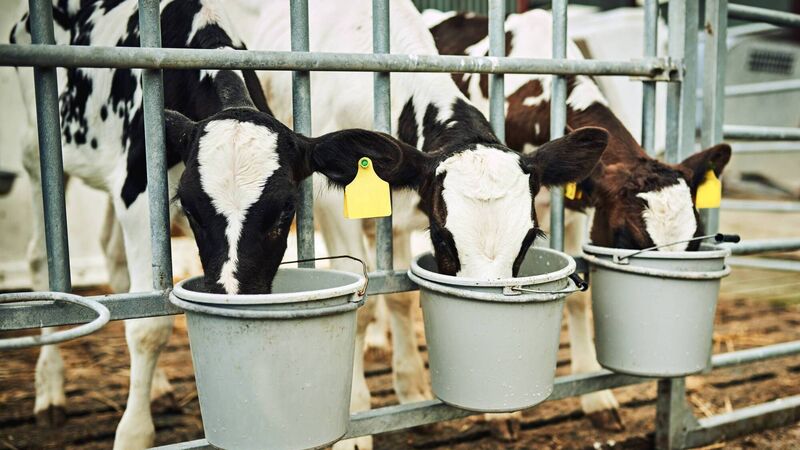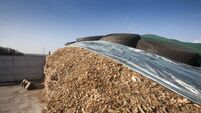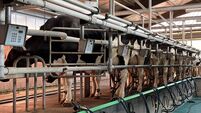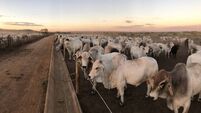What to look for in the right milk replacer for your calves

Milk replacers can be divided into two groups: whey-based powders and skim-based powders, depending on which provides the main source of dairy protein.
These days, choosing a calf milk replacer can be a minefield for producers with so many available. This market is easily divided into two groups: whey-based powders and skim-based powders, depending on which provides the main source of dairy protein. Choosing the right powder for your system is vital not only to the productivity of pre-weaning calves but also to the lifetime performance and profitability of each animal.
A calf is born in a pre-ruminant state – all four stomach chambers are present, but the rumen is undeveloped. The abomasum and omasum make up around 70% of the digestive tract in a newborn calf.
In contrast, this will eventually only account for 30%, and the rumen and reticulum, once developed, will make up the remaining 70%. The act of suckling causes the reflex of a muscular fold in the wall of the rumen called the oesophageal groove. This enables milk to be delivered directly into the abomasum. At this stage, the calf is entirely dependent on whole milk or Milk Replacer as its source of digestible proteins, fats and carbohydrates.
In the first weeks of life, renin is the predominant enzyme for protein digestion. For the first few days, the abomasum is non-acidic, which allows the antibodies in the colostrum to pass unharmed for absorption through the gut lining.
The abomasum then becomes acidic and aids protein breakdown. In time, the level of pepsin produced by the calf also increases, allowing for the digestion of non-milk proteins, such as those in forages and concentrates.
The protein in skim-based powders is found in the form of casein and in whey-based powders in the form of albumin and globulin. Whole milk contains both casein and whey protein; therefore, calf physiology is designed to digest both forms. The protein composition of whole milk is typically 80% casein and 20% whey.
The method of digestion is where skim and whey-based powders differ the most. When a skim-based milk replacer enters the abomasum, it forms a clot or curd under the influence of the enzymes rennin and pepsin.
This is the same process as making cheese and using rennet to coagulate milk proteins. The clotting of the casein allows for slower breakdown and a steady release of nutrients. The clot can take as long as 12 hours to be digested. This makes a skim-based powder better suited to those feeding once a day after 28 days, as the calf will feel more satisfied for longer.
Skim-based milk replacers will also contain whey. When the casein clots, the whey is separated and moves more quickly through the digestive tract where nutrients are absorbed in the small intestine. When feeding a whey-based powder, no clot is formed, and the entire milk feed is digested more quickly – usually within two to three hours. This can be thought to stimulate hunger and lead to higher concentration intakes from an earlier age.
Both skim and whey-based powders provide the amino acid requirements for the calf, and therefore, no differences should be seen in feed conversion efficiency or daily gains.
As I mentioned above, the calves' requirements should determine the milk replacer that you feed them. Many trials have shown there to be no difference between skim and whey-based products in terms of daily gain and gut health up to weaning. Beyond that, the next question to ask is, how much protein and fat/oils do your calves require? There is evidence to show that dairy heifers will benefit from higher protein milk replacer.
Many dairy producers will aim to supply 900g to 1,000g of powder daily to calves at peak milk intake. This is the key, as the volume of liquid fed is not what should be measured; it’s the solids that must be measured. Make sure that the powder you are using is mixed at the correct concentration based on the manufacturer's recommendations.
One of the key things to consider when choosing a powder is its ability to help drive the intake of concentrates and forage pre-weaning in order to optimise that intake post-weaning. Interestingly, there is some evidence to show that milk replacers which contain both whey and skimmed milk protein promote higher daily concentrate intakes, weight gains and frame growth.
With regard to the fat/oil content of calf milk replacer, it has been shown that when this is in excess of 20%, then it may supress starter concentrate intakes. Increasing the energy and protein intake (by feeding a high level of a high-protein, low-fat milk replacer) has been shown to increase mammary growth and development in dairy replacements, which must be considered when choosing the one for your herd.
- Brian Reidy is an independent ruminant nutritionist at Premier Farm Nutrition.












